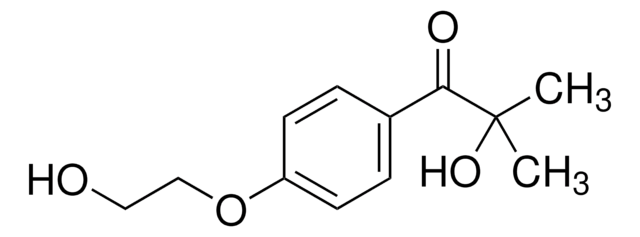729094
Poly(ethylene glycol) diacrylate
average Mn 10,000, acrylate, MEHQ as inhibitor (may contain)
Sinónimos:
Polyethylene glycol, PEG diacrylate
About This Item
Productos recomendados
product name
Poly(ethylene glycol) diacrylate, average Mn 10,000, contains MEHQ as inhibitor
formulario
solid
mol peso
average Mn 10,000
contiene
MEHQ as inhibitor
≤1,500 ppm MEHQ as inhibitor (may contain)
idoneidad de la reacción
reagent type: cross-linking reagent
reaction type: Polymerization Reactions
temperatura de transición
Tm 60-64 °C
Mw/Mn
<1.1
Ω-final
acrylate
α-final
acrylate
arquitectura del polímero
shape: linear
functionality: homobifunctional
temp. de almacenamiento
−20°C
cadena SMILES
OCCO.OC(=O)C=C
InChI
1S/C8H10O4/c1-3-7(9)11-5-6-12-8(10)4-2/h3-4H,1-2,5-6H2
Clave InChI
KUDUQBURMYMBIJ-UHFFFAOYSA-N
¿Está buscando productos similares? Visita Guía de comparación de productos
Categorías relacionadas
Aplicación
- 3D Bioprinting of Hydrogels: This study explores the formulation of PEGDA-based hydrogels for 3D bioprinting, focusing on rheological properties and structural fidelity, particularly relevant for tissue engineering applications (Wu et al., 2018).
- Sustained Ocular Drug Delivery: Investigates the delivery of small and large drug molecules using PEGDA implants, highlighting the implications for sustained drug release in ocular therapies (McAvoy et al., 2018).
- Tissue Engineering Scaffolds: Evaluates PEGDA-polycaprolactone scaffolds for tissue engineering, emphasizing the control over porosity and its importance for regenerative medicine applications (Kotturi et al., 2017).
- Photocrosslinked Hydrogel Implants: Focuses on photocrosslinked PEGDA implants for drug delivery, providing insights into the design of drug delivery systems that can be finely tuned for specific therapeutic needs (Qin et al., 2015).
- Hydrogel-Based Artificial Muscles: Characterizes PEGDA/acrylic acid hydrogels optimized for use as artificial muscles, highlighting their potential in biomedical engineering and smart materials (Browe et al., 2017).
Nota de preparación
Palabra de señalización
Danger
Frases de peligro
Consejos de prudencia
Clasificaciones de peligro
Eye Dam. 1 - Skin Irrit. 2 - Skin Sens. 1
Código de clase de almacenamiento
11 - Combustible Solids
Clase de riesgo para el agua (WGK)
WGK 1
Punto de inflamabilidad (°F)
Not applicable
Punto de inflamabilidad (°C)
Not applicable
Certificados de análisis (COA)
Busque Certificados de análisis (COA) introduciendo el número de lote del producto. Los números de lote se encuentran en la etiqueta del producto después de las palabras «Lot» o «Batch»
¿Ya tiene este producto?
Encuentre la documentación para los productos que ha comprado recientemente en la Biblioteca de documentos.
Los clientes también vieron
Artículos
In the past two decades, tissue engineering and regenerative medicine have become important interdisciplinary fields that span biology, chemistry, engineering, and medicine.
Devising biomaterial scaffolds that are capable of recapitulating critical aspects of the complex extracellular nature of living tissues in a threedimensional (3D) fashion is a challenging requirement in the field of tissue engineering and regenerative medicine.
Nuestro equipo de científicos tiene experiencia en todas las áreas de investigación: Ciencias de la vida, Ciencia de los materiales, Síntesis química, Cromatografía, Analítica y muchas otras.
Póngase en contacto con el Servicio técnico









